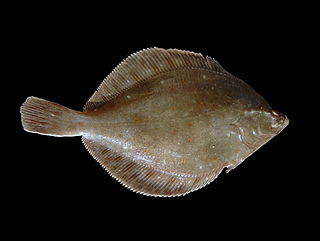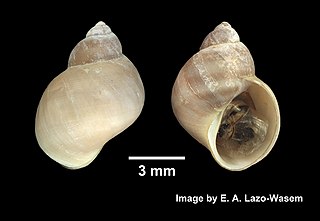
Goniatids, informally goniatites, are ammonoid cephalopods that form the order Goniatitida, derived from the more primitive Agoniatitida during the Middle Devonian some 390 million years ago. Goniatites (goniatitids) survived the Late Devonian extinction to flourish during the Carboniferous and Permian only to become extinct at the end of the Permian some 139 million years later.

The pumpkinseed, also referred to as sun perch, pond perch, common sunfish, punkie, sunfish, sunny, and kivver, is a small to medium–sized North American freshwater fish of the genus Lepomis, from family Centrarchidae in the order Perciformes.

The European plaice, commonly referred to as simply plaice, is a species of marine flatfish in the genus Pleuronectes of the family Pleuronectidae.

The gummy shark, also known as the Australian smooth hound, flake, sweet william or smooth dog-shark, is a species of ground shark in the genus Mustelus of the family Triakidae. These small to medium-sized bottom-dwelling sharks are found mostly in, but are not limited to, the area around the southern seas of Australia and is commonly baited and fished for cuisine because of its taste and market prices. According to a 2021 paper by White, Arunrugstichai & Naylorn (2021), Mustelus walkeri is the same animal as M. antarcticus. One theory is that M. walkeri is a subpopulation of M. antarcticus.

The grey triggerfish, or gray triggerfish, is a species of ray-finned fish in the triggerfish family Balistidae, the triggerfishes. The species is native to shallow parts of the western Atlantic from Nova Scotia to Argentina and also the eastern Atlantic, the Mediterranean Sea and off Angola on the west coast of Africa.

The thornback ray, or thornback skate, is a species of ray fish in the family Rajidae.

The bottlenose skate, spearnose skate, or white skate is a species of skate in the family Rajidae. It is a benthic fish native to the coastal eastern Atlantic Ocean. Due to overfishing, it has been depleted or extirpated in many parts of its former range in the northeastern Atlantic and the Mediterranean Sea, and is now endangered.

Coastal fish, also called inshore fish or neritic fish, inhabit the sea between the shoreline and the edge of the continental shelf. Since the continental shelf is usually less than 200 metres (660 ft) deep, it follows that pelagic coastal fish are generally epipelagic fish, inhabiting the sunlit epipelagic zone. Coastal fish can be contrasted with oceanic fish or offshore fish, which inhabit the deep seas beyond the continental shelves.

Bela nebula, also known as the nebular needle conch is a species of sea snail, a marine gastropod mollusk in the family Mangeliidae. It is the type species of the genus Bela.

Mangelia attenuata is a species of sea snail, a marine gastropod mollusk in the family Mangeliidae.

Cyrillia linearis is a species of sea snail, a marine gastropod mollusk in the family Raphitomidae.

Steromphala umbilicalis, common name the flat top shell, is a species of sea snail, a marine gastropod mollusk in the family Trochidae, the top snails.

Montagu's blenny, also known as the capuchin blenny, is a species of combtooth blenny found in the intertidal zones of the eastern Atlantic ocean from England to Madeira and the Canary Islands as well the Mediterranean Sea, the Black Sea and the Sea of Marmara. This species prefers rocky shores with much wave action. This species grows to a length of 7.6 centimetres (3.0 in) SL. It is the only species in the genus Coryphoblennius.

Lacuna vincta, commonly known as northern lacuna, wide lacuna, northern chink shell, or banded chink shell, is a species of sea snail, a marine gastropod mollusk in the family Littorinidae, the winkles or periwinkles. It is found intertidally and in shallow waters in both the northern Atlantic Ocean and the northern Pacific Ocean. It is a herbivore, feeding on seaweed and diatoms with its toothed radula.

Acanthochitona fascicularis, the Velvety mail shell, is a common chiton in the family Acanthochitonidae.

Caecum trachea is a species of minute sea snail, a marine gastropod mollusk or micromollusk in the family Caecidae.

Sepia elegans, the elegant cuttlefish, is a species of cuttlefish in the family Sepiidae from the eastern Atlantic Ocean and the Mediterranean Sea. It is an important species for fisheries in some parts of the Mediterranean where its population may have suffered from overfishing.

Stenochiton longicymba, the clasping stenochiton is a species of polyplacophoran mollusc with an elongated shell, in the family Ishnochitonidae. It was first described by Henri Marie Ducrotay de Blainville in 1825 and is endemic to Australia's waters.


















